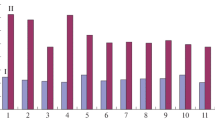Abstract
Generally, mammalian cells utilize glucose and glutamine as primary energy sources. To investigate the effect of energy sources on metabolic fluxes and antibody production, glucose- or glutamine-limited serum-free continuous culture of hybridoma 3A21 cells, which produce anti-ribonuclease A antibody, was carried out. The cell volume and dry cell weight were evaluated under various steady-state conditions. The specific consumption and production rates were evaluated on the basis of dry cell weight. On the basis of these results, the fluxes of the metabolic pathway were calculated. It was found that increasing the specific growth rate causes the specific ATP and antibody production rates to decrease. The fluxes between malate and pyruvate also decreased with the increase in specific growth rate. To increase the ATP production rate under steady-state conditions by the enhancement of fluxes between malate and pyruvate, the reduced metabolic fluxes were increased by an intermediate (pyruvate, malate, and citrate) addition. As a result, higher specific ATP and antibody production rates were achieved following the intermediate addition at a constant dilution rate.






Similar content being viewed by others
References
Butler M (2005) Animal cell cultures: recent achievements and perspectives in the production of biopharmaceuticals. Appl Microbiol Biotechnol 68:283–291
Ohya T, Hayashi T, Kiyama E, Nishii H, Miki H, Kobayashi K, Honda K, Omasa T, Ohtake H (2008) Improved production of recombinant human antithrombin III in Chinese hamster ovary cells by ATF4 overexpression. Biotechnol Bioeng 100:317–324
Yoshikawa T, Nakanishi F, Ogura Y, Oi D, Omasa T, Katakura Y, Kishimoto M, Suga K (2000) Amplified gene location in chromosomal DNA affected recombinant protein production and stability of amplified genes. Biotechnol Prog 16:710–715
Terada S, Nishimura T, Sasaki M, Yamada H, Miki M (2002) Sericin, a protein derived from silkworms, accelerates the proliferation of several mammalian cell lines including a hybridoma. Cytotechnol 40:3–12
Fujiwara M, Tsukada R, Tsujinaga Y, Takagi M (2007) Fetal calf serum-free culture of Chinese hamster ovary cells employing fish serum. Appl Microbiol Biotechnol 75:983–987
Kim BJ, Oh DJ, Chang HN (2008) Limited use of Centritech Lab II centrifuge in perfusion culture of rCHO cells for the production of recombinant antibody. Biotechnol Prog 24:166–174
Tyo KE, Alper HS, Stephanopoulos G (2007) Expanding the metabolic engineering toolbox: more options to engineer cells. Trends Biotechnol 25:132–137
Schugerl K (2001) Progress in monitoring, modeling and control of bioprocesses during the last 20 years. J Biotechnol 85:149–173
Zupke C, Stephanopoulos G (1995) Intracellular flux analysis in hybridomas using mass balances in vitro 13C NMR. Biotechnol Bioeng 45:292–303
De Alwis DM, Dutton RL, Scharer J, Moo-Young M (2007) Statistical methods in media optimization for batch and fed-batch animal cell culture. Bioprocess Biosyst Eng 30:107–113
Provost A, Bastin G, Agathos SN, Schneider YJ (2006) Metabolic design of macroscopic bioreaction models: application to Chinese hamster ovary cells. Bioprocess Biosyst Eng 29:349–366
Dorka P, Fischer C, Budman H, Scharer JM (2009) Metabolic flux-based modeling of mAb production during batch and fed-batch operations. Bioprocess Biosyst Eng 32:183–196
Balcarcel RR, Clark LM (2003) Metabolic screening of mammalian cell cultures using well-plates. Biotechnol Prog 19:98–108
Omasa T, Ishimoto M, Higashiyama K, Shioya S, Suga K (1992) The enhancement of specific antibody production rate in glucose- and glutamine-controlled fed-batch culture. Cytotechnol 8:75–84
Omasa T, Higashiyama K, Shioya S, Suga K (1992) Effect of lactate concentration on hybridoma culture in lactate-controlled fed-batch operation. Biotechnol Bioeng 39:556–564
Sharfstein ST, Tucker SN, Mancuso A, Blanch HW, Clark DS (1994) Quantitative in vivo nuclear magnetic resonance studies of hybridoma metabolism. Biotechnol Bioeng 43:1059–1074
Takiguchi N, Shimizu H, Shioya S (1997) An on-line physiological state recognition system for the lysine fermentation process based on a metabolic reaction model. Biotechnol Bioeng 55:170–181
Kompala DS, Ozutrk SS (2006) In: Ozutrk SS, Hu W-S (eds) Cell culture technology for pharmaceutical and cell-based therapies. CRC press, New York
Frame KK, Hu W-S (1990) Cell volume measurement as an estimation of mammalian cell biomass. Biotechnol Bioeng 36:191–197
Nyberg GB, Balcarcel RR, Follstad BD, Stephanopoulos G, Wang DIC (1999) Metabolism of peptide amino acids by Chinese hamster ovary cells grown in a complex medium. Biotechnol Bioeng 62:324–335
Follstad BD, Balcarcel RR, Stephanopoulos G, Wang DIC (1999) Metabolic flux analysis of hybridoma continuous culture steady state multiplicity. Biotechnol Bioeng 63:675–683
Shibuya K, Haga R, Namba M (2008) A serum substitute for fed-batch culturing of hybridoma cells. Cytotechnol 57:187–197
Genzel Y, Ritter JB, Konig S, Alt R, Reichl U (2005) Substitution of glutamine by pyruvate to reduce ammonia formation and growth inhibition of mammalian cells. Biotechnol Prog 21:58–69
Kim SH, Lee GM (2007) Functional expression of human pyruvate carboxylase for reduced lactic acid formation of Chinese hamster ovary cells (DG44). Appl Microbiol Biotechnol 76:659–665
Sellick CA, Hansen R, Maqsood AR, Dunn WB, Stephens GM, Goodacre R, Dickson AJ (2009) Effective quenching processes for physiologically valid metabolite profiling of suspension cultured mammalian cells. Anal Chem 81:174–183
Tashima Y, Hamada H, Okamoto M, Hanai T (2008) Prediction of key factor controlling G1/S phase in the mammalian cell cycle using system analysis. J Biosci Bioeng 106:368–374
Goudar C, Biener R, Zhang C, Michaels J, Piret J, Konstantinov K (2006) Towards industrial application of quasi real-time metabolic flux analysis for mammalian cell culture. Adv Biochem Eng Biotechnol 101:99–118
Acknowledgments
Parts of this paper were presented at the seventh international conference on Computer Applications in Biotechnology (CAB7) in Osaka, Japan. This work is partially supported by grants from the New Energy and Industrial Technology Development Organization of Japan, and the Program for the Promotion of Fundamental Studies in Health Sciences of the National Institute of Biomedical Innovation, and a Grant-in-Aid for Scientific Research from the Japan Society for the Promotion of Science.
Author information
Authors and Affiliations
Corresponding author
Rights and permissions
About this article
Cite this article
Omasa, T., Furuichi, K., Iemura, T. et al. Enhanced antibody production following intermediate addition based on flux analysis in mammalian cell continuous culture. Bioprocess Biosyst Eng 33, 117–125 (2010). https://doi.org/10.1007/s00449-009-0351-8
Received:
Accepted:
Published:
Issue Date:
DOI: https://doi.org/10.1007/s00449-009-0351-8




